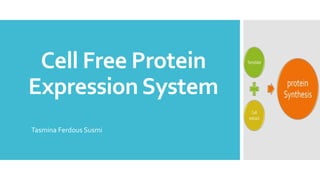
Cell free protein expression system
- 1. Cell Free Protein ExpressionSystem Tasmina Ferdous Susmi
- 2. Cell-Free Protein Expression The production of recombinant proteins in solution using bimolecular translation machinery extracted from cells. Performed without the use of living cells. All components needed to transcribe DNA to RNA and translate the RNA to protein (e.g. ribosomes, tRNAs, enzymes, cofactors, amino acids) are provided in solution for use in vitro. Such solutions are obtained through making a cell lysate from a desired cell type.
- 3. Cell-Free Protein Expression Also known as in vitro translation, cell-free protein expression, cell-free translation, or in vitro protein expression. Cell-free mixtures have been made from both bacterial and eukaryotic cells. Cell-free systems are generally not practical for large-scale protein expression.
- 4. Cell-Free Protein Expression Mechanism Two basic components are needed to accomplish in vitro protein expression: (1) the genetic template (mRNA or DNA) encoding the target protein and (2) a reaction solution containing the necessary transcriptional and translational molecular machinery. Cell extracts supply all or most of the molecules of the reaction solution, including: 1. RNA polymerases for mRNA transcription 2. ribosomes for polypeptide translation 3. tRNA and amino acids 4. enzymatic cofactors and an energy source 5. cellular components essential for proper protein folding
- 5. Mechanism Continued Cell lysates provide the correct composition and proportion of enzymes and building blocks required for translation. Usually, an energy source and amino acids must also be added to sustain synthesis. Cell membranes are removed to leave only the cytosolic and organelle components of the cell (hence the term, “cell-free extracts”). The first types of lysates developed for cell-free protein expression were derived from prokaryotic organisms. More recently, systems based on extracts from insect cells, mammalian cells and human cells have been developed and made commercially available.
- 7. Types of cell- free extracts Extracts used for cell-free protein expression are made from systems known to support high level protein synthesis. The first known cell-free extracts capable of supporting translation were made from E. coli. Extracts made from these eukaryotic systems contain all the necessary cellular macromolecules like ribosomes, translation factors and tRNAs required for efficient protein synthesis. These lysates are pretreated with micrococcal nuclease to support translation of only an exogenously supplied message. Once endogenous genes and transcripts are removed, inhibitors for the enzyme RNase are supplemented to prevent further mRNA degradation.
- 8. Types of cell- free extracts System Advantages Disadvantages E. Coli •Very high protein yield •Relatively tolerant of additives •Many eukaryotic proteins insoluble upon expression •Eukaryotic co- and post- translational modifications not possible •Codon usage is different from eukaryotes Rabbit •Mammalian system •Cap independent translation •Sensitive to additives •Protein glycosylation not possible •Co-expression of off-target proteins Wheat germ •Translation of large proteins possible •Devoid of off-target endogenous mammalian proteins •High protein yield •Mammalian co- and post- translational modifications are not possible •Premature termination of products
- 9. Types of cell- free extracts Insect •Translation of large proteins possible •No endogenous mammalian proteins •Certain forms of protein glycosylation possible •Non-mammalian Human •Human system •Co- and post- translational modifications are possible •Synthesis of functional proteins •Possible to make virus- like particles (VPLs) •Sensitive to additives •Lower yields than E. coli •New system
- 11. Rabbit Reticulocyte Lysate System Rabbit Reticulocyte Lysate (RRL), Nuclease-Treated, is optimized for mRNA translation by the addition of several supplements. In RRL translation reactions, mRNA is used as template for translation. The reticulocytes are purified to remove contaminating cells, which could otherwise alter the translational properties of the final extract. The lysate contains the cellular components necessary for protein synthesis (tRNA, ribosomes, amino acids, initiation, elongation and termination factors). Rabbit Reticulocyte Lysate may contain a variety of post- translational processing activities, including acetylation, isoprenylation and some phosphorylation activity.
- 13. Application Experiments to characterize protein–protein interactions and protein–nucleic acid interactions Rapid and high-throughput expression of mutant or truncated proteins for functional analysis Expression of mammalian proteins with proper glycosylation and native post-translational modifications (PTMs) Labeling of proteins with stable isotopes for structural analysis Production of functional virons or toxic polypeptides Analysis of components required for protein folding, protein stability or protein degradation
- 14. Advantages Important tool for molecular biologists in basic and applied sciences. Increasingly being used in high-throughput functional genomics and proteomics, with significant advantages compared to protein expression in live cells. Essential for the generation of protein arrays, such as nucleic acid programmable protein array (NAPPA) and enzyme engineering using display technologies. Cell-free approach provides the fastest way to correlate phenotype (function of expressed protein) to genotype. Indispensable for the expression of toxic proteins, membrane proteins, viral proteins and for proteins that undergo rapid proteolytic degradation by intracellular proteases.
- 15. Disadvantages Cell-free systems are generally not practical for large-scale protein expression.
